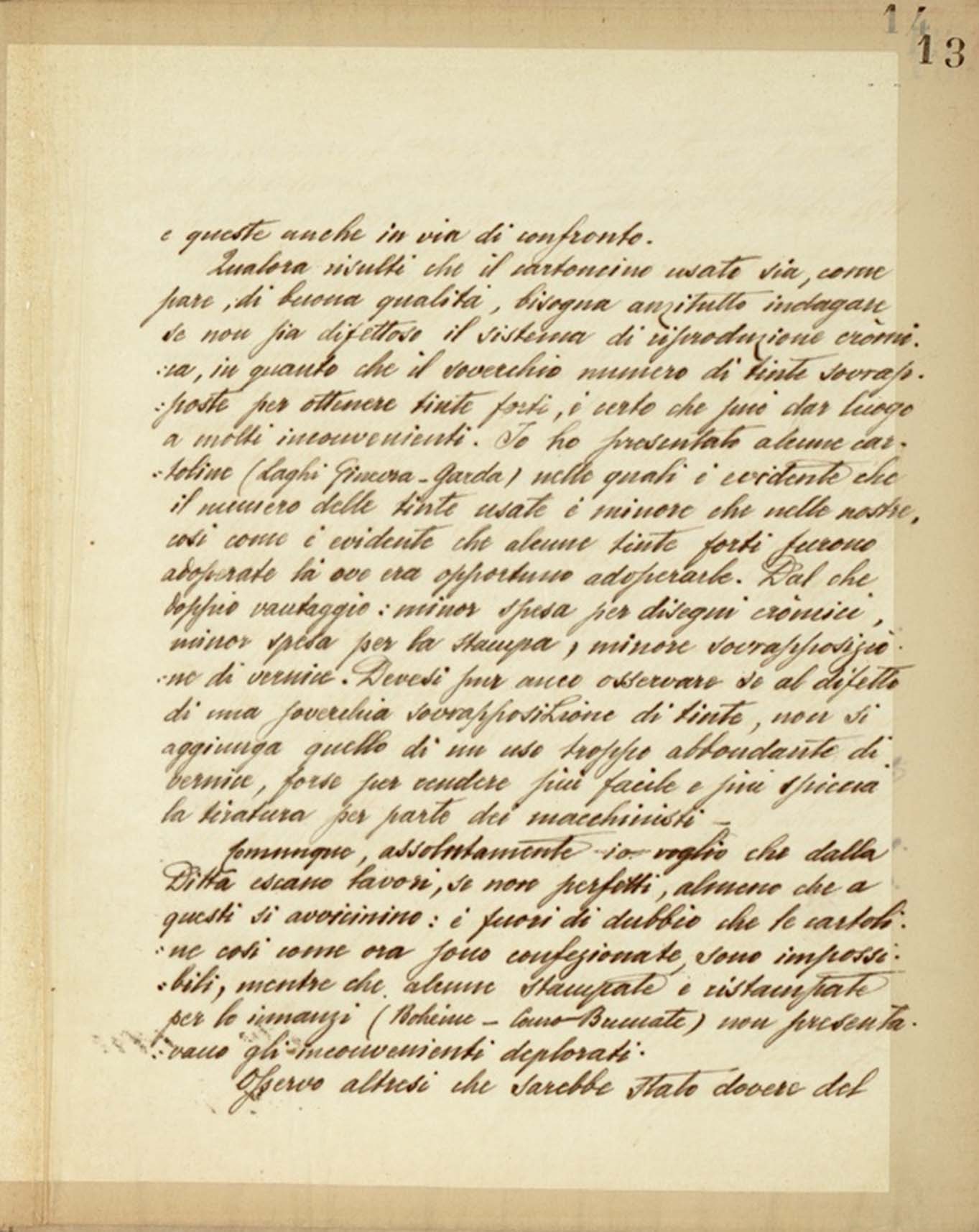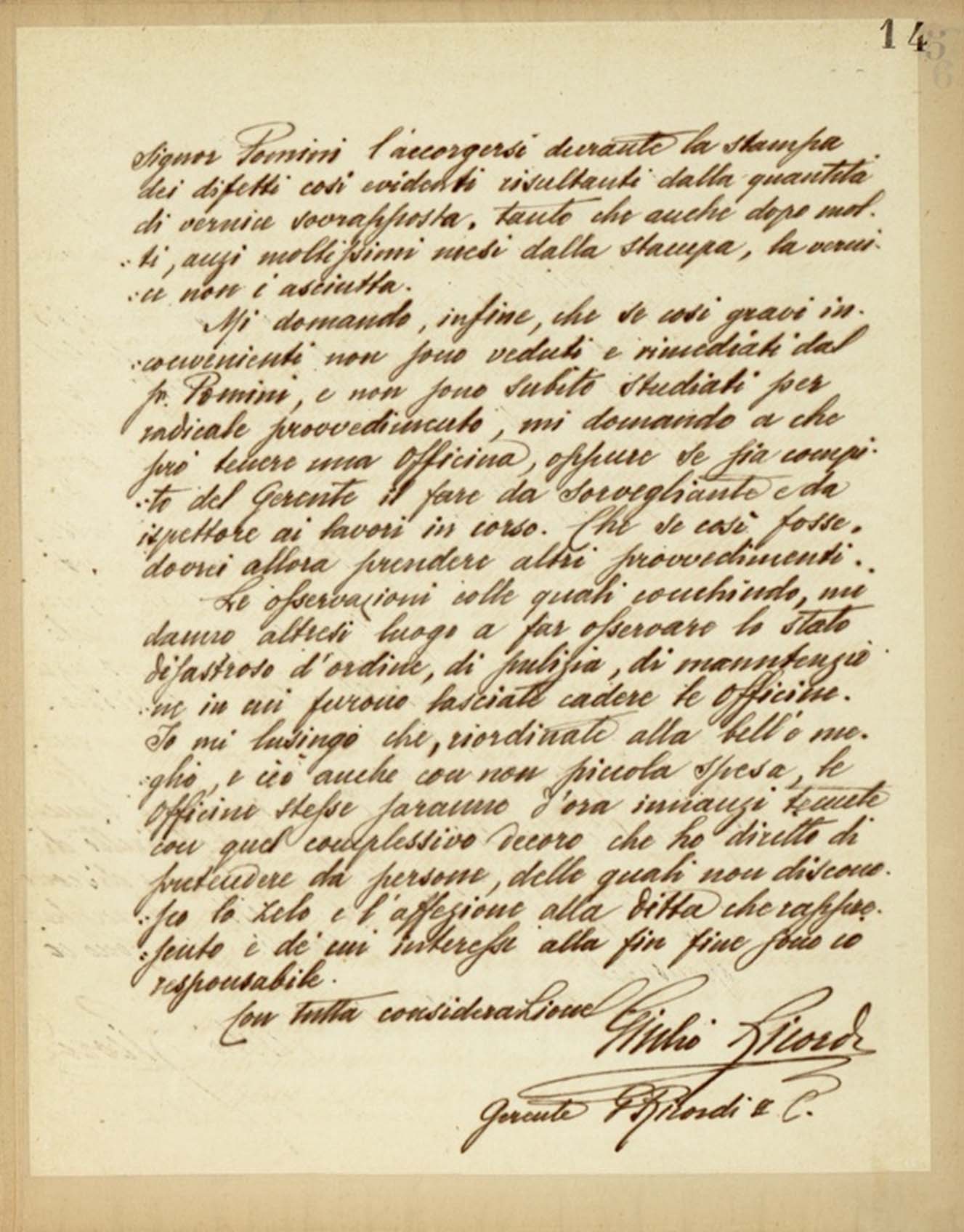


Milano 5 Dicembre 1901
On.e
In seguito alle mie personali investigazioni in merito all’inconveniente verificatosi in talune Serie di Cartoline (
- Tutte le serie di cui sopra (ed anche altre qualora risultassero difettose) devono ritirarsi dal Magazzino, che le ricaricherà alle Officine. E’ illusorio il credere vi si possa rimediare: si incontra perdita di tempo, spesa di mano d’opera inutile, e la Ditta non può, non deve mettere in commercio qualsiasi merce che, volere e volare, è avariata. La passività rimane quindi a carico delle Officine, non del Magazzino.
- Non si inizierà la stampa di nessun genere di cartoline, e non si farà ristampa alcuna, fintanto che la Direzione potrà garantire che l’inconveniente lamentato non avrà più a verificarsi. Perciò invito la Direzione a fare gli studi e le prove occorrenti - e queste anche in via di confronto.
Qualora risulti che il cartoncino usato sia, come pare, di buona qualità, bisogna anzitutto indagare se non sia difettoso il sistema di riproduzione cròmica, in quanto che il soverchio numero di tinte sovrapposte per ottenere tinte forti, è certo che può dar luogo a molti inconvenienti. Io ho presentato alcune cartoline (Laghi Ginevra-Garda) nelle quali è evidente che il numero delle tinte usate è minore che nelle nostre, così come è evidente che il numero delle tinte forti furono adoperate là dove era opportuno adoperarle. Dal che doppio vantaggio: minor spesa per disegni cròmici, minor spesa per la stampa, minore sovrapposizione di vernice. Devesi pur anco osservare se al difetto di una soverchia sovrapposizione di tinte, non si aggiunga quello di un uso troppo abbondante di vernice, forse per rendere più facile e più spiccia la tiratura per parte dei macchinisti.
Comunque, assolutamente io voglio che dalla Ditta escano lavori, se non perfetti, almeno che a questi si avvicinino: è fuori di dubbio che le cartoline così come ora sono confezionate, sono impossibili, mentre che alcune stampate e ristampate per lo innanzi (Bohème-Como Brunate) non presentavano gli inconvenienti deplorati.
Osservo altresi che sarebbe stato dovere del Signor Pomini l’accorgersi durante la stampa dei difetti così evidenti risultanti dalla quantità di vernice sovrapposta, tanto che anche dopo molti, anzi moltissimi mesi dalla stampa, la vernice non è asciutta.
Mi domando, infine, che se così gravi inconvenienti non sono veduti e rimediati dal
Le osservazioni colle quali conchiudo, mi danno altresi luogo a far osservare lo stato disastroso d’ordine, di pulizia, di manutenzione in cui furono lasciate cadere le officine.
Io mi lusingo che, riordinate alla bell’e meglio, e ciò anche con non piccola spesa, le Officine stesse saranno d’ora innanzi tenute con quel complessivo decoro che ho diritto di pretendere da persone, delle quali non disconosco lo zelo e l’affezione alla ditta che rappresento e de’ cui interessi alla fin fine sono io responsabile.
Con tutta considerazione
Giulio Ricordi
Gerente G.Ricordi & C.
2.5
pp. 12-14
CLET002096
Milan, 5 December 1901
Hon. Office of the Director, G. Ricordi & C.
City
Following my personal examination of the problems found with some of the Series of Postcards (Verdi-Iris-Tosca), in that most of them were found to be stuck to one another, I give the following strict orders, which this Office of the Director will execute as quickly as possible, and thereafter giving confirmation to the Undersigned.
- All of the series mentioned above (as well as any others which should prove to be defective) should be removed from the Warehouse, which you will then move to the Workshops. It is misleading to think that they can be fixed: that would mean a loss of time, a useless labor cost, and the Company cannot and will not place on sale any product which is, in the final analysis, defective. The loss should there be charged to the Workshops, not the Warehouse.
- No new printing of postcards of any kind shall be initiated, and none will be reprinted, until the Office of the Director can guarantee that this problem will not recur. Therefore I invite the Office of the Director to make all necessary analyses and trials, and these also by way of comparison.
Should it be demonstrated that the card stock used is of good quality, as it seems, then the color printing process should be examined, to see if it is defective, since the large number of overlaid hues – in order to obtain bold colors – may certainly cause a number of problems. I brought some postcards (Lakes Geneva and Garda), where it is clear that the number of hues utilized is fewer than in our postcards, and clear as well that the number of bold colors were used only where it was most necessary. As a result, they had a double advantage: lower costs for color separation designs, lower printing costs, fewer overlaid layers of lacquer. Your office should also examine if, in addition to the defect of an excessive number of overlaid hues, there is also an over-abundant use of lacquer, perhaps to make the printing faster and easier for the printing press operators.
In any event, I absolutely want that any product issued from this Company be, if not perfect, at least as close to perfect as possible. There is no doubt that the postcards, as they are currently produced, are unacceptable, whereas some that were previously printed and reprinted (Bohème – Como Brunate) did not have the defects I complain about above.
I further point out that it would have been the responsibility of Signor Pomini to notice during the printing process that there were such obvious defects as a result of the amount of overlaid lacquers, such that after many, indeed very many months, the lacquer has still not dried.
Finally, I ask myself how such serious problems went unnoticed and unfixed by Sig. Pomini, and as a consequence radical fixes were not immediately adopted, then I ask myself what point there is to maintaining a Workshop, and whether it should be a responsibility of the General Manager to oversee and inspect the works in production. Because if that were the case, I would have to take different measures.
These observations with which I conclude also give me the opportunity to observe the disastrous state of order, cleanliness, and maintenance into which the workshops have been allowed to fall.
I would hope that, if things were tidied up even just a bit, and this even at no small expense, the Workshops would henceforth be maintained at that overall level of decorum I have the right to expect from the employees themselves, in whom I recognize the zeal and the affection they have for the company they work for, and for whose interests, when all is said and done, I am responsible.
With best regards,
Giulio Ricordi
General Manager, G. Ricordi & C.
Milano
Lettera titolo DOC01828.005
Segnatura Volume DOC01828
Anno 1901-1909
Volume 02
Pag 012-014
Nr. pag 3

